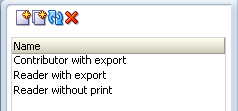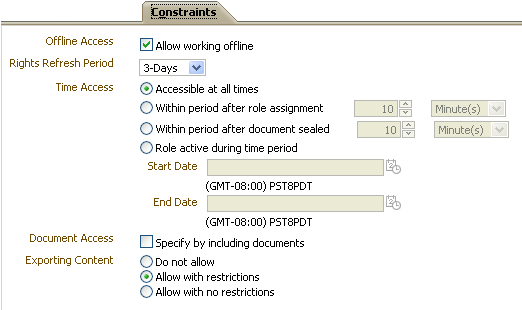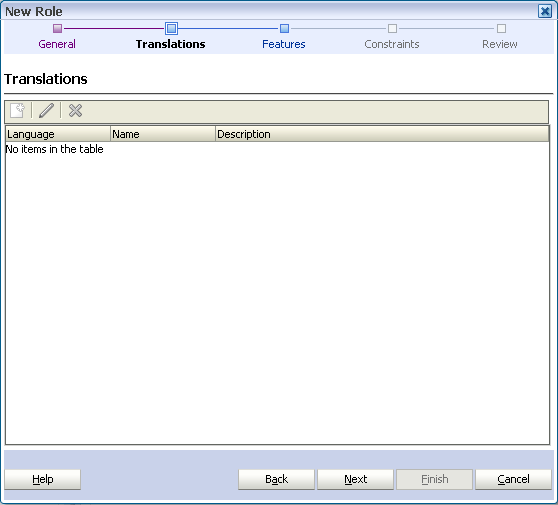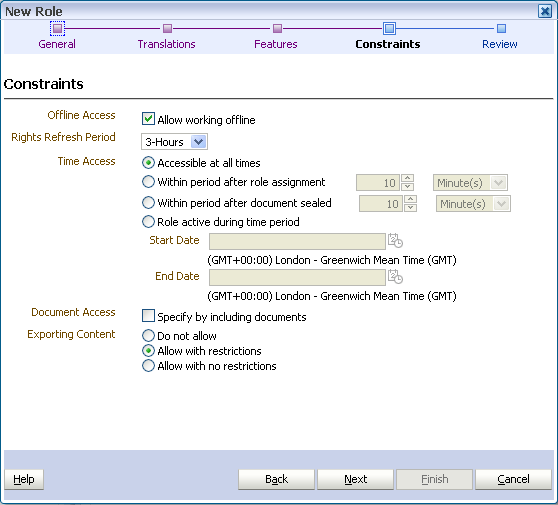| Oracle® Fusion Middleware Administrator's Guide for Oracle Information Rights Management Server Release 11.1.1.2.1 E12321-01 |
|
 Previous |
 Next |
Home > Administrator's Guide for O... > User Interface > Roles Page
| Oracle® Fusion Middleware Administrator's Guide for Oracle Information Rights Management Server Release 11.1.1.2.1 E12321-01 |
|
 Previous |
 Next |
Home > Administrator's Guide for O... > User Interface > Roles Page
The following pages and wizards are used to create, modify, set options and enter data for roles in Oracle IRM:
Use to create, copy, and delete roles, and to refresh the list of roles. Roles are created by domain administrators.
Open by clicking the Roles tab.
Left-panel controls

| Element | Description |
|---|---|
| New Role (icon) | Select to open the New Role wizard. |
| Copy (icon) | Immediately creates a copy of the role currently highlighted in the list of roles in the left panel. |
| Refresh (icon) | Select to refresh the list of roles in the left panel. You should do this to ensure that the list is showing roles that may have been created or deleted by other users. |
| Delete (icon) | Select if you want to delete the role currently highlighted in the left panel. A dialog will ask you to confirm the deletion. |
| Name | Lists all existing roles. Three standard roles are included at the time of installation. These can be used as supplied, modified before use, or deleted if not required.
Contributor with export: This role will not significantly restrict the use of sealed documents. Users given this role will be able to create, open, search, edit, and print all documents. Users will also be able to copy information to contexts on this server that have been set up as trusted contexts, and in which they have edit rights. Very importantly, users given this role will be able to create unsealed versions of documents. Reader with export: This role will not allow creation of sealed documents, but it will not significantly restrict what users can do to sealed documents that they are given access to. Users given this role will be able to open, search, and print all documents. They will also be able to reply to sealed email, with edits tracked. Very importantly, users given this role will be able to create unsealed versions of documents. Reader without print: This role will give significant protection to sealed documents. Users given this role will be able to open and search all documents. They will also be able to reply to sealed email, with edits tracked. |
Right-panel controls

| Element | Description |
|---|---|
| Apply | Select this button to apply the changes made on this page. Once selected, the changes cannot be reverted, except by making and applying new changes. |
| Revert | Select this button to cancel the changes made on this page. Does not work after the Apply button has been used. |
| Name | This text box shows the name of the role currently highlighted in the list in the left panel. You can change the name by overtyping with new text and clicking the Apply button. |
| Description | This text box shows the description of the role currently highlighted in the list in the left panel. You can change the description by overtyping with new text and clicking the Apply button. |
| Server Language | This display area shows the default server language for the role.
The server language is set on the Oracle IRM pages of the Oracle Fusion Middleware Control Console. |
Use to assign and remove sealing features for the role.
For a role to be valid, at least one of the following features must be assigned: open, seal, reseal, search, copy to, save unsealed.
Open by clicking the Features tab on the Roles page.

| Element | Description |
|---|---|
| Audit Use | Check this box if you want to record the use of this role. |
| Available | This box lists all sealing features that are not currently assigned to the role. Highlight the sealing features in this box that you want to move to the Selected box. |
| Move, Move All, Remove, Remove All | Use these controls to move sealing features between the Available and Selected boxes. The Move control and the Remove control will affect only those features that have a check mark against them. |
| Selected | This box lists the sealing features that are currently assigned to the role, or that will be once they are applied (by clicking the Apply button).
The presence or absence of check marks does not have any effect on this. |
| Details | This display area shows the details of any feature individually selected in the Available or Selected boxes. |
Use to add translations of the name and description of the current role. Also use to edit existing translations, and to delete translations that are no longer required.
Open by clicking the Translations tab on the Roles page.

| Element | Description |
|---|---|
| New Translation (icon) | Select to open the Add Translation dialog.
This is available only if translation support has been set up on the Oracle IRM pages of the Oracle Fusion Middleware Control Console. |
| Edit (icon) | Select to edit the translation currently highlighted in the Translations table. |
| Remove (icon) | Select if you want to remove the translation currently highlighted in the Translations table. A dialog will ask you to confirm the removal. |
| Language | This column identifies the language for which the translation has been created. |
| Name | For each language, this column shows the translated name. |
| Description | For each language, this column shows the translated description. |
Use to specify time and other constraints for the role.
Open by clicking the Constraints tab on the Roles page.

| Element | Description |
|---|---|
| Offline Access | Allow working offline Check this box to allow users to work on sealed documents even when they have no connection to the server (Oracle IRM Server). The maximum length of time that the user can work offline is the same as the rights refresh period (see below). |
| Rights Refresh Period | Use this drop-down list to select the maximum length of time that users can use rights before they are refreshed from the server. When the rights are refreshed, any new permissions or restrictions are applied.
The periods available here are set up on the Oracle IRM pages of the Oracle Fusion Middleware Control Console. Unless they have been changed from the defaults, the periods that you can choose from are 10 days, 3 days, 24 hours, 3 hours, and 10 minutes. Short refresh periods will generate more traffic between client and server than long refresh periods, which may be a consideration if bandwidth is restricted. |
| Time Access | You can permit access to the sealed content covered by this role at all times, or during specific periods. The default is for sealed content to be accessible at all times (to those with the right to access it). Select from the following:
Accessible at all times Choose this option if you want access to sealed content without time constraints. Within period after role assignment Choose this option if you want access restricted to a specific period after the role has been assigned to a user (that is, when a right has been created). The default period is 10 minutes, but you can change to a number of seconds, minutes, hours, days, months, or years using the controls on the right. Within period after document sealed Choose this option if you want access restricted to a specific period after a document has been sealed. The default period is 10 minutes, but you can change to a number of seconds, minutes, hours, days, months, or years using the controls on the right. Role active during time period Choose this option if you want to allow access to sealed content between two calendar dates. Enter the start and end dates directly, or use the calendar controls to select the dates. |
| Document Access | When creating and managing rights, it is possible to apply those rights to specific documents within a context, rather than to all documents within a context.
Specify by including documents Check this box to require the listing of documents to which rights do apply. |
| Exporting Content | Some sealing features control the exporting of content from a sealed document. Such export behavior can be permitted or denied on a feature-by-feature basis, or you can use these Exporting Content options to allow or disallow export of content on a broad basis. The default is to not allow export of content from sealed documents.
Do not allow Choose this option if you want no export of content from sealed documents accessed by this role. Allow with restrictions Choose this option if you want to allow export of content to trusted contexts. See "Contexts Page - Trusted Contexts". Allow with no restrictions Choose this option if you want to allow export of content from sealed documents accessed by this role. |
Use to create a new role. Roles are created by domain administrators.
Open by clicking the New Role icon in the left panel of the Roles page.
Use to name and describe a new role.
Opens by default as the first page of the New Role wizard. Can also be opened by selecting the General node in the wizard header.

| Element | Description |
|---|---|
| Name | Enter a name for the new role. |
| Description | The description will be viewable, for example, when creating other Oracle IRM components that are dependent on this one, so a brief but informative description will prove useful. |
| Server Language | Shows which language has been set as the default for this role.
The default language is set on the Oracle IRM pages of the Oracle Fusion Middleware Control Console. Translations of the name and description for the new role can be added to the Translations page of this wizard. |
Use to record translations of the name and description of the new role.
Opens as the second page of the New Role wizard. Can also be opened by selecting the Translations node in the wizard header.

| Element | Description |
|---|---|
| New Translation (icon) | Select to open the New Translation dialog, through which a language can be selected, and a translated name and description added.
This is available only if translation support has been set up on the Oracle IRM pages of the Oracle Fusion Middleware Control Console. |
| Edit (icon) | Becomes active when a row in the Translations table is selected. Opens the Edit Translation dialog for the selected translation. Use the Edit Translation dialog to make changes to the name and description of an existing translation. You cannot change the language. |
| Remove (icon) | Use to remove the translation currently highlighted in the Translations table. You will be asked to confirm the removal. |
Use to assign and remove sealing features for the role. Features control the ability of users to create and use sealed documents. These features equate to Oracle IRM Desktop "rights".
For a role to be valid, at least one of the following features must be assigned: open, seal, reseal, search.
Opens as the third page of the New Role wizard. Can also be opened by selecting the Features node in the wizard header.

| Element | Description |
|---|---|
| Available | This box lists all sealing features that are not currently assigned to the role. Select each one to see its description in the Details area. Highlight the features in this box that you want to move to the Selected box. |
| Move, Move All, Remove, Remove All | Use these controls to move user names between the Available and Selected boxes. The Move control and the Remove control will affect only those features that have a check mark against them. |
| Selected | Sealing features listed in this box will be applied to the role when the wizard is completed. The presence or absence of check marks does not have any effect on this. |
| Audit Use | Check this box if you want to record the use of this role. |
| Details | This display area shows the details of any feature individually selected in the Available or Selected boxes |
Use to specify time and other constraints for the role.
Opens as the fourth page of the New Role wizard. Can also be opened by selecting the Constraints node in the wizard header.

| Element | Description |
|---|---|
| Offline Access | Allow working offline Check this box to allow users to work on sealed documents even when they have no connection to the server (Oracle IRM Server). The maximum length of time that the user can work offline is the same as the rights refresh period (see below). |
| Rights Refresh Period | Use this drop-down list to select the maximum length of time that users can use rights before they are refreshed from the server. When the rights are refreshed, any new permissions or restrictions are applied.
The periods available here are set up on the Oracle IRM pages of the Oracle Fusion Middleware Control Console. Unless they have been changed from the defaults, the periods that you can choose from are 10 days, 3 days, 24 hours, 3 hours, and 10 minutes. Short refresh periods will generate more traffic between client and server than long refresh periods, which may be a consideration if bandwidth is restricted. |
| Time Access | You can permit access to the sealed content covered by this role at all times, or during specific periods. The default is for sealed content to be accessible at all times (to those with the right to access it). Select from the following:
Accessible at all times Choose this option if you want access to sealed content without time constraints. Within period after role assignment Choose this option if you want access restricted to a specific period after the role has been assigned to a user (that is, when a right has been created). The default period is 10 minutes, but you can change to a number of seconds, minutes, hours, days, months, or years using the controls on the right. Within period after document sealed Choose this option if you want access restricted to a specific period after a document has been sealed. The default period is 10 minutes, but you can change to a number of seconds, minutes, hours, days, months, or years using the controls on the right. Role active during time period Choose this option if you want to allow access to sealed content between two calendar dates. Enter the start and end dates directly, or use the calendar controls to select the dates. |
| Document Access | When creating and managing rights, it is possible to apply those rights to specific documents within a context, rather than to all documents within a context.
Specify by including documents Check this box to require the listing of documents to which rights do apply. |
| Exporting Content | Some sealing features control the exporting of content from a sealed document. Such export behavior can be permitted or denied on a feature-by-feature basis, or you can use these Exporting Content options to allow or disallow export of content on a broad basis. The default is to not allow export of content from sealed documents.
Do not allow Choose this option if you want no export of content from sealed documents accessed by this role. Allow with restrictions Choose this option if you want to allow export of content to trusted contexts. See "Contexts Page - Trusted Contexts". Allow with no restrictions Choose this option if you want to allow export of content from sealed documents accessed by this role. |
Use to review the choices made and information entered on the previous wizard pages.
Opens as the final page of the wizard. Can also be opened by selecting the Review node in the wizard header.

If you are not satisfied with the choices and entries shown on the Summary page, use the Back button to return to the wizard pages and make changes.
If you are satisfied with the choices and entries shown on the Summary page, create the new role by clicking the Finish button.